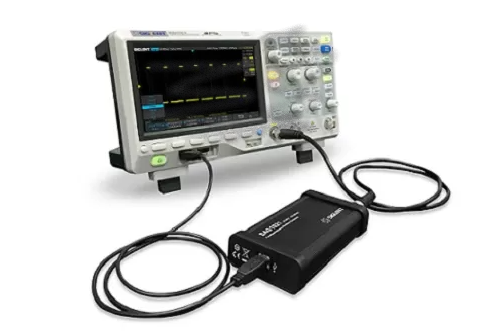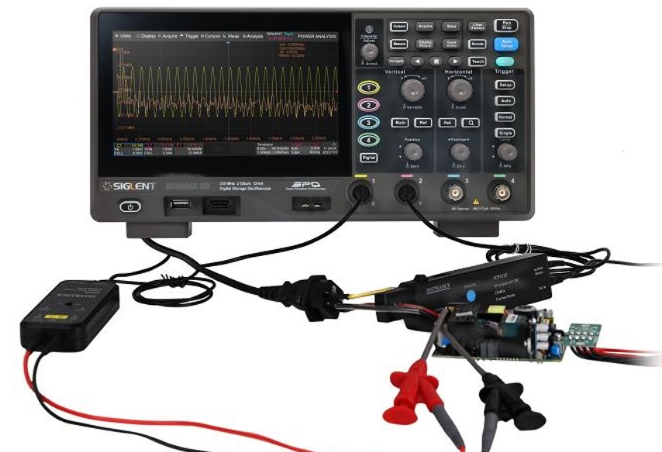Introduction to Siglent SDS814X-HD vs SDS2202X-E
When it comes to oscilloscopes, choosing the right model can feel like navigating a complex maze. Two of the standout contenders in this arena are the Siglent SDS814X-HD and the SDS2202X-E. Both models have earned their stripes among engineers and hobbyists alike, but they cater to different needs and preferences. Whether you’re debugging circuits or exploring waveforms, having the right tool at your disposal is crucial.
In this ultimate comparison guide, we’ll dive deep into these two powerful oscilloscopes. We’ll explore their similarities and differences in specifications, performance, ease of use, pricing, and real-world feedback from users just like you. By the end of our journey together, you’ll be equipped with all the knowledge needed to make an informed decision on which oscilloscope best fits your requirements!
Similarities between the two oscilloscope models
The Siglent SDS814X-HD and SDS2202X-E share several notable similarities that make them appealing to electronics enthusiasts. Both models feature a 10.1-inch display, providing clear visibility of waveforms and measurements.
They are equipped with advanced triggering capabilities, which enhance their functionality for various applications. Users benefit from an extensive bandwidth range in both scopes, ensuring they can handle diverse signals effectively.
Additionally, both oscilloscopes support USB connectivity for easy data transfer and storage. This compatibility allows users to save their work seamlessly or connect to external devices without hassle.
Moreover, the intuitive interface design is another common trait that simplifies operation for beginners and experienced users alike. With similar software features like automatic measurements and waveform math functions, these models offer versatility in analyzing electronic signals efficiently.
Differences in specifications and features
The Siglent SDS814X-HD vs SDS2202X-E come with distinct specifications that cater to different user needs. The SDS814X-HD boasts a higher bandwidth of 1 GHz, making it ideal for high-frequency signals. This feature is particularly advantageous in advanced electronics research and development.
On the other hand, the SDS2202X-E offers a bandwidth of 200 MHz, which is sufficient for many general applications. It’s perfect for those who work primarily with lower frequency ranges or educational purposes.
In terms of sampling rate, the SDS814X-HD excels with up to 4 GSa/s compared to the 1 GSa/s offered by its counterpart. This difference allows for more detailed signal representation in complex waveforms.
Both models offer deep memory capabilities but differ slightly; this affects how long users can capture data without losing detail during high-speed operations.

Performance comparison in real-world applications
When testing the Siglent SDS814X-HD and SDS2202X-E in real-world scenarios, distinct characteristics come to light.
The SDS814X-HD boasts a higher bandwidth of 1 GHz, making it better suited for high-frequency signals. Engineers often find this advantage crucial when analyzing fast transients or digital communications.
On the other hand, the SDS2202X-E offers impressive performance at a lower price point. With its 200 MHz bandwidth and advanced triggering capabilities, it’s ideal for educational purposes and basic troubleshooting tasks.
In practice, users report that both oscilloscopes deliver stable waveforms with clear visibility even under complex signal conditions. The ability to capture glitches is notable in both models; however, professionals may favor the enhanced sampling rate of the SDS814X-HD for intricate designs.
Application requirements will dictate which model shines brighter in your workspace. Each has its strengths tailored to specific user needs and environments.
User-friendliness and interface design
User-friendliness plays a significant role when comparing the Siglent SDS814X-HD and the SDS2202X-E. Both models boast intuitive interfaces, though their approaches differ slightly.
The SDS814X-HD features a large touchscreen display that provides vivid visuals and straightforward navigation. Users can easily access various functions with simple taps, enhancing overall efficiency during complex tasks.
On the other hand, the SDS2202X-E has a more traditional layout but still prioritizes user experience. Its buttons are well-placed and responsive, allowing quick adjustments without getting lost in menus.
Both oscilloscopes offer customizable settings tailored to individual preferences, which adds to their appeal for diverse users. Whether you’re an experienced technician or just starting out, each model ensures you won’t struggle while working on your projects.
Price comparison and value for money
When comparing the Siglent SDS814X-HD and SDS2202X-E, price can be a decisive factor for many buyers. The SDS814X-HD generally comes at a higher price point, reflecting its advanced features and specifications.
This model boasts an impressive bandwidth of 1GHz, making it suitable for high-frequency applications. It caters to professionals who demand precision in their work.
On the other hand, the SDS2202X-E offers excellent performance at a more accessible price range. With a bandwidth of 200MHz, this oscilloscope is ideal for hobbyists and educators looking for reliable functionality without breaking the bank.
Both models provide great value considering their capabilities. Depending on your specific needs—whether professional or educational—you’ll find each option justifies its cost with distinct advantages that cater to different users in the spectrum of electronics testing.
Customer reviews and feedback
Customer feedback plays a crucial role in understanding the strengths and weaknesses of both the Siglent SDS814X-HD vs SDS2202X-E. Users often praise the build quality of these models, noting their durability even under rigorous testing conditions.
Many technicians appreciate the user-friendly interfaces, which make navigating through various functions intuitive. This ease of use helps beginners quickly get up to speed with complex measurements.
On the downside, some users have expressed concerns about specific features like bandwidth limitations in certain applications. The SDS814X-HD is frequently highlighted for its advanced triggering capabilities, while others favor the price-to-performance ratio of the SDS2202X-E.
Satisfaction ratings remain high across both models, showcasing that each oscilloscope meets essential needs effectively. Customer testimonials provide valuable insights into real-world performance that can help potential buyers make informed decisions.
Which model is best suited for different needs?
When considering which model fits your needs best, it’s essential to reflect on the specific applications you have in mind.
The Siglent SDS814X-HD excels for those who require high bandwidth and deep memory capabilities. Ideal for advanced research or complex signal analysis, its features cater well to professional environments.
On the other hand, the SDS2202X-E offers a solid balance of performance and affordability. It suits hobbyists and students who need reliable measurements without breaking the bank.
If portability is paramount, both oscilloscopes can be used effectively in various settings, but their weights may influence your choice based on how often you’ll move between locations.
For educational purposes, the user-friendly interface of the SDS2202X-E might appeal more to beginners learning fundamental concepts.
Assessing your priorities—whether they are budget constraints or technical specifications—will guide you toward making the right selection.
Final verdict: Which one should you choose?
Choosing between the Siglent SDS814X-HD vs SDS2202X-E ultimately hinges on your specific needs.
For professionals requiring high bandwidth and advanced features, the SDS814X-HD shines with its capabilities. It’s designed for extensive analysis and complex applications.
Conversely, if you’re looking for a reliable oscilloscope that fits well in educational settings or simpler projects, the SDS2202X-E offers great value without sacrificing performance.
Consider your typical use cases—are you diving into intricate circuits regularly? Or do you primarily troubleshoot basic electronics?
Budget is another vital factor. The pricing of each model reflects their unique features. Assess what aligns with your financial plan while ensuring it meets all necessary specifications.
Factor in how often you’ll need tech support or upgrades too; this can influence long-term satisfaction with either choice.
Conclusion
When weighing the Siglent SDS814X-HD vs SDS2202X-E, it’s essential to consider your specific needs. Each model has its strengths that cater to different users.
If you’re focused on advanced features and a higher bandwidth, the SDS814X-HD may catch your attention. Its performance excels in complex applications.
On the other hand, if you seek reliability and essential functionalities for education or basic tasks, the SDS2202X-E stands out as a solid choice.
The decision isn’t just about specifications; it’s about how each oscilloscope aligns with your projects. Think about what matters most—be it price point or user experience.
Choosing between these two models can enhance your work significantly. Take time to evaluate what fits best within your workflow for optimal results.
Frequently Asked Questions (FAQs)
When it comes to oscilloscopes, understanding the nuances between models can make all the difference. The Siglent SDS814X-HD and SDS2202X-E both offer unique features, catering to different user needs.
The FAQs section is where we address common queries that potential buyers often have regarding these two oscilloscopes.
What are the key differences in bandwidth?
The SDS814X-HD has a higher bandwidth of 1 GHz compared to the SDS2202X-E’s 200 MHz. This makes it more suitable for high-frequency applications.
Is there a significant price gap between the two models?
Yes, generally, the SDS814X-HD is on the pricier side due to its advanced specifications and capabilities.
Which model is recommended for beginners?
For those new to oscilloscopes, many users suggest starting with the SDS2202X-E because of its simpler interface and lower cost.
Can both models be used for automotive diagnostics?
Both oscilloscope models can handle automotive diagnostics; however, if you’re dealing with complex signals frequently found in modern vehicles, you might prefer the higher specs of the SDS814X-HD.
Are any software updates available for these scopes?
Yes, Siglent provides firmware updates regularly. Users should check their official site or follow instructions provided with their devices for easy upgrades.
Whether you opt for one model over another will depend on your specific needs and budget. Both options come highly recommended within their respective categories.
